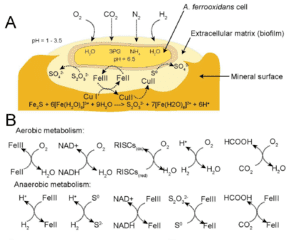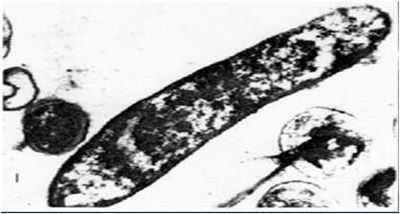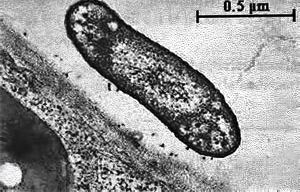Family Acidithiobacillaceae Higher classification Acidithiobacillaceae | Kingdom Eubacteria Scientific name Acidithiobacillus Rank Genus | |
 | ||
Similar Acidithiobacillus ferrooxidans, Acidithiobacillus thiooxidans, Bacteria, Thiobacillus, Leptospirillum ferriphilum | ||
Alternative metabolism acidithiobacillus ferrooxidans
Acidithiobacillus is a genus of the Acidithiobacillia in the "Proteobacteria". Like all "Proteobacteria", Acidithiobacillus spp. are Gram-negative. Some members of this genus were classified as Thiobacillus spp., before they were reclassified in 2000.
Contents
- Alternative metabolism acidithiobacillus ferrooxidans
- Acidithiobacillus ferroxidans metabolism from genome sequence to industrial applications
- Genus Acidithiobacillus
- Bioleaching
- Morphology
- Phylogeny
- References


Both of these species are used in the biohydrometallurgy industry in methods called bioleaching and biomining, whereby metals are extracted from their ores through bacterial oxidation.

Acidithiobacillus ferroxidans metabolism from genome sequence to industrial applications
Genus Acidithiobacillus

Acidithiobacillus are acidophilic obligate autotrophs (Acidithiobacillus caldus can also grow mixotrophically) that use elementary sulfur, tetrathionate and ferrous iron as electron donors. They assimilate carbon from carbon dioxide using the transaldolase variant of the Calvin-Benson-Bassham cycle. The genus comprises motile, rod-shaped cells that can be isolated from low pH environments including low pH microenvironments on otherwise neutral mineral grains.
Bioleaching
Acidithiobacillus ferrooxidans has emerged as an economically significant bacterium in the field of biohydrometallurgy, in the leaching of sulfide ores since its discovery in 1950 by Colmer, Temple and Hinkle. The discovery of A. ferrooxidans led to the development of “biohydrometallurgy”, which deals with all aspects of microbial mediated extraction of metals from minerals or solid wastes and acid mine drainage. A. ferrooxidans has been proven as a potent leaching organism, for dissolution of metals from low-grade sulfide ores. Recently, the attention has been focused upon the treatment of mineral concentrates, as well as complex sulfide ores using batch or continuous-flow reactors.
Acidithiobacillus ferrooxidans is commonly found in acid mine drainage and mine tailings. The oxidation of ferrous iron and reduced sulfur oxyanions, metal sulfides and elementary sulfur results in the production of ferric sulfate in sulfuric acid, this in turn causes the solubilization of metals and other compounds. As a result, A. ferrooxidans may be of interest for bioremediation processes.
Morphology
Acidithiobacillus spp. occur as single cells or occasionally in pairs or chains, depending on growth conditions. Highly motile species have been described, as well as nonmotile ones. Motile strains have a single flagellum with the exception of A. albertensis, which has a tuft of polar flagellae and a glycocalyx. Nitrogen fixation also is an important ecological function carried out by some species in this genus, as is growth using molecular hydrogen as a source of energy - neither property are found in every species. Ferric iron can be used by some species as a terminal electron acceptor.
Phylogeny
This genus the other genus in the order Acidithiobacillales (i.e. Thermithiobacillus) were formerly members of the Gammaproteobacteria, with considerable debate regarding their position and that they could also fall within the Betaproteobacteria, but the situation was resolved by whole-genome alignment studies and both genera have been reclassified to the new class Acidithiobacillia.
